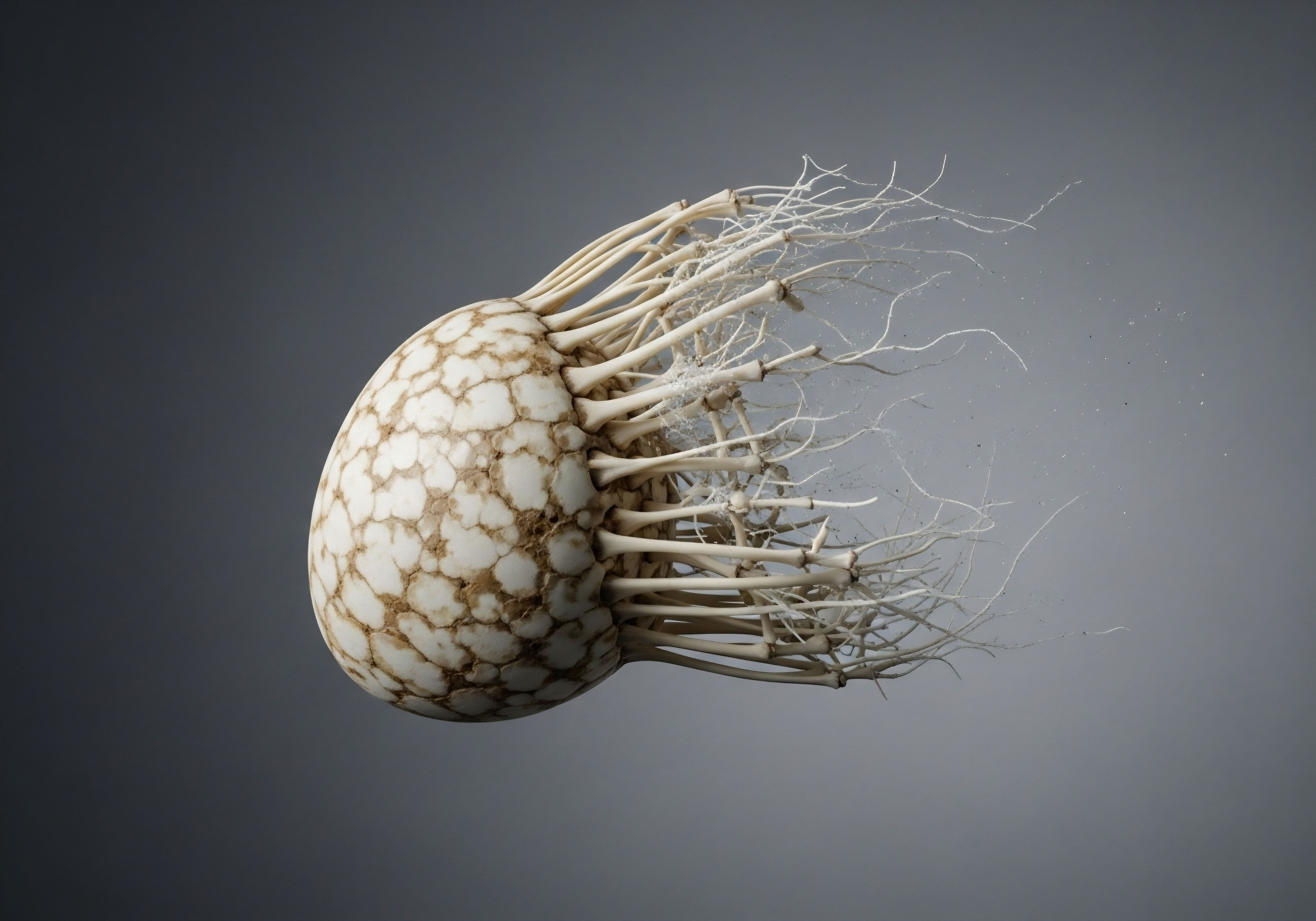

Fundamentals
Perhaps you have experienced moments where your body simply does not feel like your own. A subtle shift in energy, a change in mood, or a quiet decline in vitality can leave you wondering about the underlying causes. These sensations, often dismissed as normal aging or daily stress, frequently signal deeper biological conversations occurring within your system. Understanding these internal communications, particularly those involving hormones, represents a significant step toward reclaiming your well-being.
Among the many chemical messengers orchestrating your bodily functions, dehydroepiandrosterone (DHEA) holds a unique position. It is a steroid hormone produced primarily by your adrenal glands, small organs situated atop your kidneys. The brain and gonads also contribute to its production.
DHEA acts as a precursor, meaning it serves as a raw material that your body can convert into other essential hormones, including androgens (like testosterone) and estrogens (like estradiol). This makes DHEA a foundational element in the complex network of your endocrine system.
DHEA functions as a crucial precursor, allowing the body to synthesize other vital hormones.
The levels of DHEA in your body naturally fluctuate throughout your life. They typically rise during puberty, reaching their highest concentrations in your twenties and early thirties. After this peak, a gradual, age-related decline begins, often referred to as “adrenopause.” This reduction occurs independently of menopausal status, affecting women across their lifespan.

The Adrenal Glands and DHEA Production
Your adrenal glands are central to DHEA synthesis. These glands are remarkable for their ability to produce a variety of hormones that regulate stress response, metabolism, and blood pressure. The outer layer of the adrenal gland, known as the adrenal cortex, contains a specific zone called the zona reticularis, which is the primary site for DHEA and its sulfated form, DHEA-sulfate (DHEA-S) production.
DHEA-S is the more abundant circulating form, serving as a stable reservoir that can be converted back to DHEA as needed.
The adrenal glands operate under the influence of the hypothalamic-pituitary-adrenal (HPA) axis, a sophisticated feedback system. The hypothalamus, a region in your brain, sends signals to the pituitary gland, which then releases adrenocorticotropic hormone (ACTH). ACTH, in turn, stimulates the adrenal glands to produce DHEA and other adrenal hormones. This intricate communication system ensures that hormone levels remain balanced, responding to the body’s needs and external stressors.

Why DHEA Matters for Women
For women, DHEA’s role extends beyond its simple presence. As a precursor, it contributes significantly to the body’s pool of androgens and estrogens, particularly as ovarian hormone production declines with age. In premenopausal women, approximately 75% of androgens are derived from adrenal precursors like DHEA, a proportion that rises to 100% in postmenopausal women. This makes DHEA a vital source of sex steroids in peripheral tissues, where it can be locally converted into active hormones.
When DHEA levels diminish, women may experience a range of symptoms that can significantly impact their daily lives. These can include ∞
- Reduced energy levels ∞ A persistent feeling of tiredness or a lack of vigor.
- Changes in mood ∞ Increased irritability, feelings of sadness, or difficulty managing stress.
- Decreased libido ∞ A noticeable reduction in sexual desire or responsiveness.
- Cognitive shifts ∞ Difficulties with memory, focus, or mental clarity.
- Physical alterations ∞ Dry skin, thinning hair, or a reduction in muscle mass.
These symptoms, while often attributed to other factors, can frequently be linked to an imbalance in the body’s hormonal landscape, with DHEA playing a quiet, yet fundamental, part. Understanding this connection is the first step toward exploring avenues for restoration and enhanced vitality.


Intermediate
Moving beyond the foundational understanding of DHEA, we now consider its clinical implications and how it integrates into personalized wellness protocols for women. The body’s hormonal system operates like a sophisticated internal messaging service, with DHEA acting as a versatile, unassigned message that can be adapted into various specific directives as needed. When this messaging system experiences disruptions, clinical evaluation becomes paramount to identify the precise nature of the imbalance.

Assessing DHEA Status in Women
Evaluating DHEA levels typically involves measuring DHEA-sulfate (DHEA-S) in the blood. DHEA-S is preferred for testing because its levels are more stable throughout the day compared to unconjugated DHEA. A comprehensive assessment considers not only the absolute DHEA-S level but also the individual’s age, symptoms, and overall health picture. Reference ranges for DHEA-S vary significantly with age, reflecting the natural decline observed over time.
DHEA-S blood tests offer a stable measure of DHEA status, guiding personalized health strategies.
Interpreting DHEA-S levels requires a clinician’s expertise. A level considered “normal” for a 70-year-old woman might be significantly low for a 35-year-old experiencing symptoms of hormonal imbalance. The goal of DHEA optimization is often to restore levels to those typical of a younger, healthier adult, rather than simply within the broad “normal” range for one’s chronological age.

When Is DHEA Supplementation Considered?
DHEA supplementation is not a universal solution, but it can be a valuable component of a personalized protocol for specific presentations in women. Clinical research has explored its utility in several areas ∞
- Adrenal Insufficiency ∞ Women with primary or secondary adrenal insufficiency often exhibit very low DHEA levels. In these cases, DHEA supplementation has shown small but consistent benefits in improving quality of life and mood.
- Vulvovaginal Atrophy and Sexual Health ∞ Local administration of DHEA (as an intravaginal suppository, prasterone) has demonstrated significant benefits in addressing symptoms of vulvovaginal atrophy, such as dryness and painful intercourse, in postmenopausal women. Oral DHEA may also contribute to improvements in sexual function, including libido, in some women.
- Bone Mineral Density ∞ Studies suggest DHEA supplementation may contribute to increased bone formation and improved bone mineral density, particularly in postmenopausal women.
- Mood and Well-being ∞ Some evidence indicates DHEA can positively influence mood and reduce symptoms of depression in certain populations, especially those with adrenal insufficiency.
- Metabolic Health ∞ DHEA may play a part in supporting healthy metabolic function, with some research indicating potential benefits for insulin sensitivity and body composition.
It is important to note that while DHEA is available over-the-counter, its use should always be guided by a qualified healthcare provider. This ensures appropriate dosing, monitoring for potential side effects, and integration with other aspects of a comprehensive health strategy.

DHEA’s Interplay with Other Hormones
DHEA does not operate in isolation; it functions as a key player within the broader hormonal orchestra. Its conversion into androgens and estrogens means that DHEA levels directly influence the availability of these downstream hormones. This interconnectedness is particularly relevant when considering hormonal optimization protocols.

Testosterone Replacement Therapy for Women
For women experiencing symptoms of low testosterone, such as diminished libido, fatigue, or reduced muscle mass, direct testosterone replacement therapy (TRT) is a common consideration. Protocols often involve low-dose Testosterone Cypionate, typically administered weekly via subcutaneous injection (e.g. 10 ∞ 20 units or 0.1 ∞ 0.2ml). Pellet therapy, offering long-acting testosterone, also represents an option. DHEA supplementation can complement these approaches by providing a natural substrate for endogenous testosterone production, potentially allowing for lower exogenous testosterone doses or supporting overall androgen balance.
The body’s ability to convert DHEA into testosterone is a testament to its adaptive internal machinery. This conversion occurs in various peripheral tissues, allowing for localized hormone production based on specific tissue needs.

Progesterone and Estrogen Balance
DHEA also contributes to the body’s estrogen pool. While the ovaries are the primary source of estrogen in premenopausal women, peripheral conversion of DHEA becomes increasingly significant after menopause. This conversion helps maintain a baseline level of estrogens, which are vital for bone health, cardiovascular function, and cognitive well-being.
When considering hormonal optimization, progesterone is often prescribed, particularly for peri- and postmenopausal women, to balance estrogenic effects and support uterine health. In some cases, an aromatase inhibitor like Anastrozole might be used alongside testosterone therapy to prevent excessive conversion of androgens to estrogens, ensuring a balanced hormonal environment. DHEA’s role as a precursor means its levels influence the starting materials for both androgen and estrogen pathways, making its assessment a valuable part of a holistic hormonal picture.
The table below illustrates how DHEA levels change with age and the typical ranges observed in women.
| Age Range (Years) | Typical DHEA-S Levels (µg/dL) | Clinical Considerations |
|---|---|---|
| 20-29 | 140-450 | Peak production, optimal vitality. |
| 30-39 | 90-390 | Gradual decline begins, subtle changes may appear. |
| 40-49 | 60-260 | More noticeable decline, perimenopausal symptoms may align. |
| 50-59 | 30-190 | Significant reduction, postmenopausal symptoms common. |
| 60+ | 10-100 | Lowest levels, potential for age-related decline in function. |
These ranges serve as a guide, but individual symptoms and clinical context always guide treatment decisions. A personalized approach acknowledges that optimal health is not merely about fitting into a statistical range, but about restoring the body’s innate capacity for balance and function.


Academic
The physiological significance of DHEA extends into the intricate molecular pathways governing steroidogenesis and cellular function. A deep understanding of DHEA’s role necessitates an exploration of its biosynthesis, metabolism, and its influence on various biological axes, moving beyond its simple classification as a precursor hormone. The body’s internal regulatory systems operate with remarkable precision, akin to a highly sophisticated chemical factory where raw materials are meticulously transformed into specialized products, each with a distinct purpose.

DHEA Biosynthesis and Steroidogenic Pathways
DHEA synthesis initiates from cholesterol, the foundational molecule for all steroid hormones. Within the mitochondria of adrenal cortical cells, cholesterol is converted to pregnenolone by the enzyme cholesterol side-chain cleavage enzyme (CYP11A1 or P450scc). Pregnenolone then undergoes hydroxylation at the 17-alpha position by 17-alpha-hydroxylase (CYP17A1), yielding 17-alpha-hydroxypregnenolone. This intermediate is then acted upon by the 17,20-lyase activity of the same CYP17A1 enzyme, leading to the formation of DHEA.
The adrenal cortex, particularly the zona reticularis, is the primary site for this synthesis, accounting for the vast majority of circulating DHEA-S. A smaller proportion of DHEA is also produced in the gonads and the brain, where it functions as a neurosteroid, influencing neural activity and cognitive processes.

Intracrinology ∞ Local Hormone Production
A critical concept in understanding DHEA’s widespread effects is intracrinology. This term describes the local synthesis and action of sex steroids within peripheral tissues from circulating inactive precursors like DHEA and DHEA-S. Instead of relying solely on hormones produced by the adrenal glands or ovaries, many tissues possess the necessary enzymes to convert DHEA into active androgens (like testosterone and dihydrotestosterone) and estrogens (like estradiol and estrone) directly within their cells.
This localized conversion allows for tissue-specific hormonal regulation, ensuring that each cell receives the precise amount of active steroid it requires, without flooding the entire system with high levels of potent hormones. For example, DHEA can be converted to testosterone in muscle cells to support protein synthesis, or to estrogen in bone cells to maintain bone density. This intricate local control mechanism highlights DHEA’s strategic importance as a widely available substrate for targeted hormonal action.

DHEA’s Influence on Biological Systems
The widespread distribution of DHEA-converting enzymes means its influence extends across numerous physiological systems. Its impact is not limited to reproductive health but encompasses metabolic regulation, immune function, and neurocognitive processes.

Metabolic Health and Body Composition
Research indicates a connection between DHEA levels and metabolic markers. Studies have shown that DHEA supplementation can lead to reductions in visceral and subcutaneous fat areas, alongside improvements in insulin sensitivity. This suggests a role for DHEA in the prevention and management of metabolic syndrome, particularly when associated with abdominal adiposity in women.
The mechanisms likely involve DHEA’s influence on glucose metabolism and lipid profiles, potentially through its conversion to androgens and estrogens, which are known to affect insulin signaling and fat distribution.

Bone Density and Skeletal Integrity
Declining DHEA levels with age correlate with decreased bone mineral density, a significant concern for postmenopausal women. Clinical trials have explored DHEA’s potential to counteract this. A 12-month administration of DHEA in postmenopausal women resulted in increased bone formation markers and higher bone mineral density. This effect is likely mediated by the local conversion of DHEA to estrogens within bone tissue, as estrogens are crucial regulators of bone remodeling and maintenance.

Neurocognitive Function and Mood Regulation
DHEA acts as a neurosteroid, meaning it is synthesized in the brain and influences neuronal activity. It can modulate neurotransmitter systems and receptor functions, potentially affecting mood, cognition, and stress response. Some studies have observed small improvements in mood and depressive symptoms with DHEA supplementation, particularly in women with adrenal insufficiency. The precise mechanisms are still under investigation, but they may involve DHEA’s direct effects on brain receptors or its conversion to other neuroactive steroids.

Clinical Evidence and Considerations for DHEA Therapy
While DHEA holds promise, the clinical evidence for its broad application in healthy women remains complex and, in some areas, inconsistent. Meta-analyses of DHEA administration in peri- and postmenopausal women have shown mixed results for general quality of life, menopausal symptoms, and sexual function, though specific benefits for vulvovaginal atrophy are well-established with local application.
A significant consideration with DHEA supplementation is the potential for androgenic side effects, such as acne and hirsutism (excessive hair growth), especially with higher doses or in individuals with increased sensitivity to androgens. This underscores the necessity of individualized dosing and careful monitoring of clinical response and laboratory parameters.

Integrating DHEA with Comprehensive Hormone Protocols
DHEA therapy, when indicated, is best viewed as a component of a broader, personalized hormone optimization strategy. For instance, in women undergoing Testosterone Replacement Therapy (TRT), DHEA can serve as an endogenous source of androgens, complementing exogenous testosterone administration. This approach respects the body’s natural steroidogenic pathways.
Other advanced protocols, such as Growth Hormone Peptide Therapy, also operate within the broader endocrine landscape. Peptides like Sermorelin, Ipamorelin / CJC-1295, and Tesamorelin aim to stimulate the body’s natural growth hormone release, influencing metabolism, body composition, and cellular repair.
While not directly related to DHEA’s precursor function, these therapies collectively contribute to an optimized internal environment where all hormonal systems can function more effectively. Similarly, targeted peptides like PT-141 for sexual health or Pentadeca Arginate (PDA) for tissue repair address specific physiological needs, often in conjunction with a balanced hormonal foundation that DHEA helps to establish.
The table below summarizes key clinical findings regarding DHEA supplementation in women ∞
| Clinical Area | Observed Effects of DHEA Supplementation | Level of Evidence / Considerations |
|---|---|---|
| Adrenal Insufficiency | Small improvements in quality of life and mood. | Consistent, but benefits are modest. |
| Vulvovaginal Atrophy | Significant improvement with local (intravaginal) DHEA. | Strong evidence for local application. |
| Sexual Function (Libido) | Mixed results; some studies show benefit, others do not. | Variable individual response; more consistent with local application for dyspareunia. |
| Bone Mineral Density | Potential for increased bone formation and density. | Promising, especially in postmenopausal women. |
| Mood / Depression | Some improvements, particularly in adrenal insufficiency. | Limited to specific populations; not a general antidepressant. |
| Metabolic Parameters | Potential for improved insulin sensitivity, reduced fat mass. | Emerging evidence; requires further research. |
| General Well-being / Anti-aging | No consistent beneficial effects in healthy women. | “Fountain of youth” claims lack robust scientific backing. |
Understanding the nuances of DHEA’s actions and its place within the complex hormonal ecosystem allows for a more precise and effective approach to personalized wellness. It is a testament to the body’s inherent capacity for self-regulation, given the right support and intelligent guidance.

References
- Arlt, W. (2004). The Adrenal Androgen DHEA as a Cardiovascular Hormone. European Journal of Endocrinology, 150(1), 1-14.
- Karasek, M. (2005). Dehydroepiandrosterone (DHEA) in postmenopausal women. Menopause Review/Przegląd Menopauzalny, 4(4), 8-13.
- Labrie, F. Luu-The, V. Labrie, C. & Bélanger, A. (2005). DHEA and its transformation into androgens and estrogens in peripheral target tissues ∞ intracrinology. Reviews in Endocrine and Metabolic Disorders, 6(3), 197-209.
- Panjari, M. & Davis, S. R. (2007). DHEA in women ∞ a review of the safety and efficacy. Maturitas, 57(1), 22-27.
- Genazzani, A. R. Stomati, M. Valentino, V. & Pluchino, N. (2003). DHEA and its sulfate in postmenopausal women ∞ a review. Gynecological Endocrinology, 17(1), 1-14.
- Scheffers, C. S. et al. (2015). Dehydroepiandrosterone for women in the peri- or postmenopausal phase. Cochrane Database of Systematic Reviews, (1).
- Davis, S. R. et al. (2021). Prescribing testosterone and DHEA ∞ The role of androgens in women. Cleveland Clinic Journal of Medicine, 88(1), 49-57.
- Traish, A. M. et al. (2011). Dehydroepiandrosterone (DHEA) ∞ A precursor steroid or an active hormone in human physiology. Journal of Andrology, 32(1), 3-1 Traish.
- Samaras, N. et al. (2020). Should Dehydroepiandrosterone Be Administered to Women? The Journal of Clinical Endocrinology & Metabolism, 106(1), 245-256.
- Liu, H. et al. (2021). Dehydroepiandrosterone Shifts Energy Metabolism to Increase Mitochondrial Biogenesis in Female Fertility with Advancing Age. Oxidative Medicine and Cellular Longevity, 2021.
- Genazzani, A. R. et al. (2024). Influences of Oral Dehydroepiandrosterone (DHEA) Administration on Hormonal Profile, Menopausal Clinical Symptoms and Sexual Function in Early Postmenopausal Symptomatic Women. The Journal of Clinical Endocrinology & Metabolism, 109(4), 1045-1055.
- Rutkowska, M. & Rachoń, D. (2020). Supplementation of dehydroepiandrosterone (DHEA) in pre- and postmenopausal women ∞ position statement of expert panel of Polish Menopause and Andropause Society. Ginekologia Polska, 91(9), 554-562.

Reflection
As you consider the intricate dance of hormones within your own body, particularly the quiet influence of DHEA, you may find yourself with a renewed sense of agency. The journey toward optimal health is deeply personal, and understanding the biological underpinnings of your experiences is a powerful starting point. This knowledge is not merely academic; it is a lens through which you can view your symptoms, concerns, and aspirations with greater clarity.
The information presented here offers a framework for comprehending the complex interactions that shape your vitality. It is a reminder that your body possesses remarkable systems designed for balance and restoration. The path to reclaiming your full potential often involves precise, individualized guidance, tailored to your unique physiological blueprint. Consider this exploration a step in your ongoing dialogue with your own biology, a conversation that promises deeper understanding and a renewed sense of well-being.



